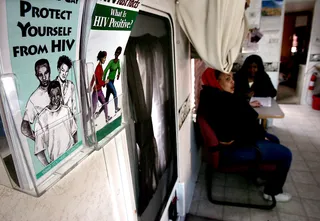National Women and Girls HIV/AIDS Awareness Day
March 10 is National Women and Girls HIV/AIDS Awareness Day

1 / 8
Women and HIV/AIDS - Today, March 10, is National Women and Girls HIV/AIDS Awareness Day. Groups across the country will hold events aimed at encouraging women to get tested and seek treatment if necessary. The day will also hopefully shed light on the gaps in access to care that many American women still face.Although men make up the majority of HIV/AIDS cases in the U.S., the epidemic has had a ravaging effect on the health of women and has fast become the leading cause of death for those aged 15 to 44. Black women make up a large percentage of those cases and represent the fastest-growing population in regards to rate of infections in the country. (Photo: Dimas Ardian/Getty Images)

2 / 8
Getting Tested - National Women and Girls HIV/AIDS Awareness Day offers an opportunity for community groups, government agencies, and health care providers to raise awareness about women’s vulnerability to HIV and the challenges faced by those living with the virus. Please GET TESTED! Knowing your status is the ONLY way to protect your long-term health. The Centers for Disease Control and Prevention recommends regular HIV tests regardless of sexual practice for people age 13–64. (Photo: Spencer Platt/Getty Images )

3 / 8
Use a Condom - You increase your chances of contracting HIV and AIDS by having multiple sex partners or having anal, vaginal or oral sex without a condom. Sharing needles or equipment for drug use can also increase your chances of contracting HIV. (Photo: Spencer Platt/Getty Images )

4 / 8
Disparaties in Access to Care - Biologically, women are more susceptible than men to HIV infection through heterosexual sex. And women are often subject to social and economic factors—such as discrimination and poverty—that place them at greater risk. Research has also shown that HIV-positive women face gaps in access to treatment and care compared to men, often due to financial constraints or the responsibility of caring for children and other family members. (Photo: Alex Wong/Getty Images)

5 / 8
Knowledge Is Power - Knowledge and awareness of risk factors and the best testing practices are two of the biggest keys in the fight against HIV and AIDS. Overall, women account for 27 percent of new HIV infections each year and represent 25 percent of those living with HIV, according to the Centers for Disease Control and Prevention (CDC). Approximately every 35 minutes, a woman tests positive for HIV in America.(Photo: Spencer Platt/Getty Images )
Photo By Spencer Platt/Getty Images
ADVERTISEMENT

6 / 8
Women of Color at Risk - Women of color are disproportionately affected by HIV and AIDS. The rate of new infections for African-American women is nearly 15 times higher than that for white women, and for Latinas it is four times higher than for white women. Young women are especially at risk.Black women account for 66 percent of new HIV/AIDS infections. Up to 75 percent of those infected report heterosexual sex as the most likely cause. (Photo: Brent Stirton/Getty Images)

7 / 8
What's Your Status? - The sooner you know your status, the more treatment options will be available to you. Knowing your HIV status can empower you to continue doing the right things.(Photo: Spencer Platt/Getty Images )
